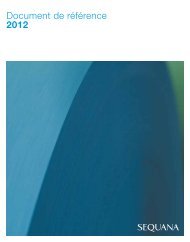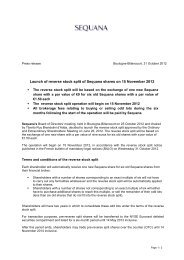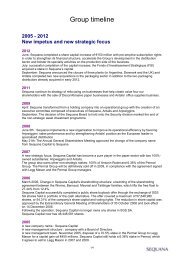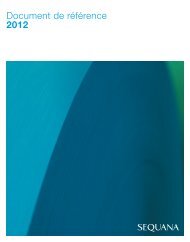Contents
Registration document PDF - Sequana
Registration document PDF - Sequana
You also want an ePaper? Increase the reach of your titles
YUMPU automatically turns print PDFs into web optimized ePapers that Google loves.
Corporate social responsibility6Organisational governanceDecision-making structure and processSequana is continually strengthening its decision-making systemin order to guarantee the utmost transparency when implementingactions and strategies. The Group endeavours to use financialand natural resources and its human capital as effectively as possibleand in a way that better reflects its commitment to socialresponsibility. It also aims to achieve a fair balance between thedegree of power, responsibility and expertise of its decision-makers.It strives to keep track of the implementation of these decisionsin order to ensure that they are implemented in a responsiblemanner and to determine accountability for the positive or negativeoutcomes they may have. The CSR function is representedon the Group’s three main executive committees (Sequana,Arjowiggins and Antalis), either systematically or on an ad hocbasis, ensuring it a voice on the Group’s highest decision-makingbody. After a CSR department was set up in 2011, a networkof CSR correspondents was formally appointed and effective in2012. For Arjowiggins, the CSR department comprises one representativefor each division as well as for the medical/hospitalbusiness. For Antalis, the CSR department comprises one correspondentfor each region, one for the Packaging business, andone for Antalis’ headquarters. The role of these correspondentsis to act as the focal point between their specific entity and theGroup and to promote cross-functional cooperation via workinggroups and other exchanges. For more technical issues, the CSRnetwork was also strengthened and a correspondent systematicallyappointed in every entity for energy/environment, safety andproduct matters. The HR network was already in place and formallydesignated before this reorganisation.The CSR correspondents report to the Group Head of CSR andtheir work is discussed during face-to-face meetings or videoconferences, depending on the subject concerned. Entities mayalso put in place CSR initiatives or organisations at a local level.Promotion of diversitySequana is an international group and its operations span fivecontinents. Although it is chiefly present in Europe, whichaccounts for 77% of its employees, 6% of its staff are based inNorth America, 9% in South America, 4% in Asia and Australiaand 4% in Africa. This international dimension means that theGroup is not inclined to differentiate its policies along the linesof national or ethnic criteria but constantly seeks to capitalise onthe mutually enriching interplay between various cultures. Theexecutive committees of Antalis and Arjowiggins boast a totalof seven different nationalities and all of the nationalities presentin the Group are represented on the various operating committeesand at the regular management meetings, proof of Sequana’smulti-cultural and international profile.Due to the industrial and logistic nature of the Group’s businesses,ensuring a diverse workforce is not always easy, particularly asregards the employment of staff with disabilities. Obtaining statisticsfor staff with disabilities is made more complex by differentlocal laws and regulations, which may prevent such data beingcollected or may be based on a different definition of disability.Disabled staff make up 1.99% of employees at Antalis (basedon 14 entities representing 53% of the workforce) and 2.79% atArjowiggins (based on 12 entities representing 71% of the workforce).This percentage is 2.42% for the Group (based on 61% ofthe workforce).Dialogue and relations with stakeholdersAs a global paper group, Sequana’s responsibility towards its differentstakeholders (listed below) is important and is based onthe principles of transparency, accountability, cooperation andresponsible communication. Constructive dialogue is an integralpart of forging a well-balanced group in terms of economic,social, environmental and responsibility issues, and a means ofguaranteeing Sequana’s existence over the long term.Stakeholder mappingThe Group has to deal on an occasional or regular basis withmany different economic, social and environmental players fromthe private, institutional or not-for-profit sectors. Stakeholderswhose needs and expectations need to be considered include:■■Customers: focused mainly on the business-to-business sector, theGroup’s customers are mainly major paper manufacturers, printers,service companies, paper distributors and government bodies.Their expectations in terms of corporate social responsibilityissues vary widely from one country and business to the next: somerequire guarantees from the Group that it respects core CSR valuesand principles while others look to Sequana for guidance andinspiration in these fields.■■Shareholders/investors: Sequana’s main responsibility towards itsshareholders in terms of CSR is a duty of transparency and disclosureregarding its actions and obligations. Shareholders and investorsshould be provided with all of the information they need toensure that they are dealing with a responsible corporate citizen.■ ■ Suppliers: Sequana works with a large number of suppliers inboth its distribution and production businesses. The expectationsof these suppliers should be met through a process of constructive,ethical dialogue, and assurance sought that they also respectand continually enforce the Group’s CSR values. Clearly statingits principles and values in any dealings it may have with suppliersboth upstream and downstream of its production and distributionactivities is a crucial part of its responsibility. Sequana helpsits suppliers engineer positive changes in their businesses, therebyreinforcing the policies it espouses internally.Sequana | 2012 Document de référence (English version) | 197









